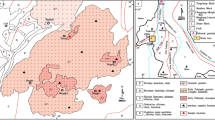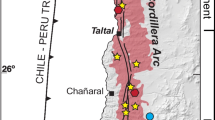Abstract
Melting experiments carried out at 1-atm and at 2 kbar on mid-ocean ridge basalts dredged from the mid-Atlantic ridge near the Kane Fracture Zone (KFZ, 22° to 25° N. latitude) provide a basis for evaluating the role of crystal fractionation in generating compositional variability observed in “normal” mid-ocean ridge basalt. The 1-atm olivine-plagioclase-clinopyroxene saturation boundary for KFZ lavas defines a path in mineral projection schemes and in oxide-oxide diagrams that is displaced from the same experimentally determined boundaries in FAMOUS (Grove and Bryan 1983) and Oceanographer Fracture Zone (Walker et al. 1979) basalts. The glass margins of sparsely phyric KFZ lavas record small amounts of near surface, low pressure fractional crystallization, and their glass and bulk rock compositions are similar. An important signature of low pressure differentiation is recorded in the quenched glass margins of moderately phyric KFZ lavas compared to their bulk rock compositions, and the glass has evolved along low-pressure fractionation paths that are similar to those produced in the 1-atm experiments. Many of the lavas have retained phenocrysts in equilibrium proportions, so that their bulk rock compositions represent liquid compositions. When the effects of near-surface differentiation and crystal accumulation are removed from the Kane data set, and only liquid compositions are considered, a suite of basalt magmas can be identified that forms a trend in mineral component projection schemes parallel to the 1-atm oliv-plag-cpx multiple saturation boundary, but displaced from it toward olivine. These basalts have only olivine and plagioclase as phenocrysts, and are well removed from clinopyroxene saturation at low pressure. The compositional variation can not be generated by mixing any primary liquid composition with a low pressure liquid that has evolved along the oliv-plag-cpx multiple saturation boundary. Major and trace element models of this trend using olivine, plagioclase and clinopyroxene as fractionating phases match the compositional variability. This compositional trend is generated by fractionation at pressures greater than 2 kbar, but within the plagioclase stability field. A review of the data for other normal MORB suites from this part of the mid-Atlantic ridge reveals a similar elevated pressure fractionation signature which persists when the effects of low pressure magma mixing are removed from the data set.
Similar content being viewed by others
References
Albee AL, Ray L (1970) Correction factors for electron microprobe microanalysis of silicates, oxides, carbonates, phosphates and sulfates. Anal Chem 42:1408–1414
Bence AE, Albee AL (1968) Empirical correction factors for the electron microanalysis of silicates and oxides. J Geol 76:382–403
Bender JF, Hodges FN, Bence AE (1978) Petrogenesis of basalts from the project famous area: experimental study from 0 to 15 kbars. Earth Planet Sci Lett 41:277–302
Bevington PR (1969) Data reduction and error analysis for the physical sciences. McGraw-Hill New York, p 336
Biggar GM (1972) Diopside, lithium metasilicate and the 1968 temperature scale. Mineral Mag 38:768–770
Biggar GM (1984) The composition of diopside solid solutions, and of liquids, in equilibrium with forsterite, plagioclase, and liquid in the system Na2O-CaO-MgO-Al2O3-SiO2 and in remelted rocks from 1 bar to 12 kbar. Mineral Mag 48:481–494
Bougault H, Hekinian R (1974) Rift valley in the Atlantic Ocean near 36°50′ N: Petrology and geochemistry of basaltic rocks. Earth Planet Sci Lett 24:249–261
Bowen NL (1928) The Evolution of the Igneous Rocks. Princeton University Press, p 332
Bryan, WB (1979) Regional variation and petrogenesis of basalt glasses from the FAMOUS Area, Mid-Atlantic Ridge. J Petrol 20:293–325
Bryan WB (1983) Systematics of modal phenocryst assemblages in submarine basalts: petrologic implications. Contrib Mineral Petrol 83:62–74
Bryan WB (1986) Linked evolutionary data arrays: A logical structure for petrologic modeling of multisource, multiprocess magmatic systems. J Geophys Res 91:5891–5900
Bryan WB, Moore JG (1977) Compositional variation of young basalts in the mid-Atlantic rift valley near latitude 36°49′ N. Geol Soc Am Bull 88:556–570
Bryan WB, Finger LW, Chayes F (1969) Estimating proportions in petrographic mixing equations by least squares approximation. Science 163:926–927
Bryan WB, Thompson G, Ludden, JN (1981) Compositional variation in normal MORB from 22°–25°N; Mid-Atlantic Ridge and Kane Fracture Zone, J Geophys Res 86:11815–11836
Carmichael ISE, Turner FJ, Verhoogen J (1974) Igneous petrology. McGraw-Hill Book Company, p 739
Corigan G, Gibb GF (1979) The loss of Fe and Na from a basaltic melt during experiments using wire loop method. Mineral Mag 43:121–126
Donaldson CH (1979) Composition changes in basalt melt contained in a wire loop of Pt80 Rh20: Effect of temperature, time, and oxygen fugacity. Mineral Mag 43:115–119
Dungan MA, Rhodes, JM (1978) Residual glasses and melt inclusions in basalts from DSDP Legs 45 and 46: Evidence for magma mixing. Contrib Mineral Petrol 67:417–431
Dungan MA, Rhodes JM, Long PE, Blanchard DP, Brannon JC, Rodgers KV (1978) The petrology and geochemistry of basalts from site 396 legs 45 and 46 of the Deep Sea Drilling Project.In:Initial reports of the Deep Sea Drilling Project 46:89–113
Engel AEJ, Engel CG, Havens, RG (1965) Chemical characteristics of oceanic basalts and the upper mantle. Geol Soc Am Bull 76:719–734
Fujii T, Bougault H (1983) Melting relations of a magnesian abyssal tholeiite and the origin of MORBs. Earth Planet Sci Lett 62:283–295
Fujii T, Kushiro I (1977) Melting relations and viscosity of an abyssal tholeiite. Carnegie Inst Washington Yearb 76:461–465
Fujii T, Kushiro I, Hamuro K (1978) Melting relations and viscosity of an abyssal olivine tholeiite. Initial reports of the Deep Sea Drilling Project 45:513–517
Fujimaki H, Tatsumoto M, Aoki K (1984) Partition coefficients of Hf, Zr, and REE between phenocrysts and groundmasses. J Geophys Res 89:B662-B672
Grove TL (1981) Use of FePt alloys to eliminate the iron loss problem in 1-atmosphere gas mixing experiments: theoretical and practical considerations. Contrib Mineral Petrol 78:298–304
Grove TL, Bryan WB (1983) Fractionation of pyroxene-phyric MORB at low pressure: an experimental study. Contrib Mineral Petrol 84:293–309
Grove TL, Donnelly-Nolan JM (1986) The evolution of young silicic lavas at Medicine Lake volcano, California: Implications for the origins of compositional gaps in calc-alkaline series lavas. Contrib Mineral Petrol 92:281–302
Hart SR, Davis KE (1978) Nickel partitioning between olivine and silicate melt. Earth Planet Sci Lett 40:203–219
Hofmann AW (1980) Diffusion in natural silicate melts: a critical review. In: Hargraves RB (ed) Physics of Magmatic Processes. Princeton University Press, p 585
Irving AJ (1978) A review of experimental studies of crystal/liquid trace element partitioning. Geochim Cosmochim Acta 42:743–770
Karson JA, Dick HJB (1983) Tectonics of ridge-transform intersections at the Kane Fracture Zone. Mar Geophys Res 6:51–98
Kushiro I (1973) Origin of magmas in oceanic and circum-oceanic regions. Tectonophysics 17:211–222
Langmuir CH, Bender JF (1984) The geochemistry of oceanic basalts in the vicinity of transform faults: observations and implications. Earth Planet Sci Lett 69:107–127
Machado N, Ludden JN, Brooks C, Thompson G (1983) Fine scale isotopic heterogeneity in the sub-Atlantic mantle. Nature 295:226–229
Melson WG, Thompson G, van Andel Tj H (1968) Volcanism and metamorphism in the mid-Atlantic Ridge, 22° N latitude. J Geophys Res 73:5925–5941
Miyashiro A, Shido F, Ewing M (1969) Diversity and origin of abyssal tholeiite from the Mid-Atlantic Ridge near 24° and 30° North latitude. Contrib Mineral Petrol 23:38–52
Muir ID, Tilley CE (1966) Basalts from the northern part of the Mid-Atlantic Ridge, II, The Atlantic collection near 30°N. J Petrol 7:193–201
Muir ID, Tilley CE, Scoon JH (1964) Basalts from the northern part of the rift zone of the Mid-Atlantic Ridge. J Petrol 5:409–434
O'Donnell TH, Presnall DC (1980) Chemical variations of the glass and mineral phases in basalts dredged from 25°–30° N along the mid-Atlantic ridge. Am J Sci 280:845–868
O'Hara MJ (1968) Are ocean floor basalts primary magma? Nature 220:683–686
O'Hara MJ (1976) Percentage of crystallinity and calculated liquid composition in experimental samples.In: MacKenzie WS (ed) Progress in Experimental Petrology 1972–1975. Nat Environ Res Counc Pub 6:194–195
O'Hara MJ, Mathews RE (1981) Geochemical evolution in an advancing periodically replenished, periodically tapped, continuously fractionated magma chamber. J Geol Soc London 138:237–277
Philpotts JA, Schnetzler CC (1970) Phenocryst-matrix partition coefficients for K, Rb, Sr and Ba, with applications to anorthosite and basalt genesis. Geochim Cosmochim Acta 36:1131–1166
Presnall DC, Hoover JD (1984) Composition and depth of origin of primary mid-ocean ridge basalts. Contrib Mineral Petrol 87:170–178
Presnall DC, Dixon JR, O'Donnell TH, Dixon SA (1979) Generation of mid-ocean ridge tholeiites. J Petrol 20:3–35
Rhodes JM, Blanchard DP, Dungan MA, Rodgers KV, Brannon JC (1978) Chemistry of Leg 45 basalts.In:Initial reports of the Deep Sea Drilling Project 45:447–459
Schroeder B, Thomspon G, Sulanowska M, Ludden JN (1980) Analysis of geologic materials using an automated x-ray fluoresence system. X-Ray Spectrom 9:198–205
Staudigel H, Bryan WB (1981) Contrasted glass-whole rock compositions and phenocryst re-distribution, IPOD sites 417 and 418. Contrib Mineral Petrol 78:255–262
Steele IM, Lindstrom DJ (1981) Ni partitioning between diopside and silicate melt: A redetermination by ion microprobe and recognition of an experimental problem. Geochim Cosmochim Acta 45:2177–2183
Stolper E (1980) A phase diagram for mid-ocean ridge basalts: Preliminary results and implications for petrogenesis. Contrib Mineral Petrol 78:13–27
Taylor JR (1982) An introduction to error analysis. University Science Books, Mill Valley, Ca, p 270
Thompson G, Bryan WB, Ballard R, Hamuro K, Melson, WG (1985) Axial processes along a segment of the East Pacific Rise, 10°–12° N. Nature 318:429–433
Walker D, Shibata T, Delong SE (1979) Abyssal tholeiites from the Oceanographer Fracture Zone II: Phase equilibria and mixing. Contrib Mineral Petrol 70:111–125
Author information
Authors and Affiliations
Rights and permissions
About this article
Cite this article
Tormey, D.R., Grove, T.L. & Bryan, W.B. Experimental petrology of normal MORB near the Kane Fracture Zone: 22°–25° N, mid-Atlantic ridge. Contr. Mineral. and Petrol. 96, 121–139 (1987). https://doi.org/10.1007/BF00375227
Received:
Accepted:
Issue Date:
DOI: https://doi.org/10.1007/BF00375227




